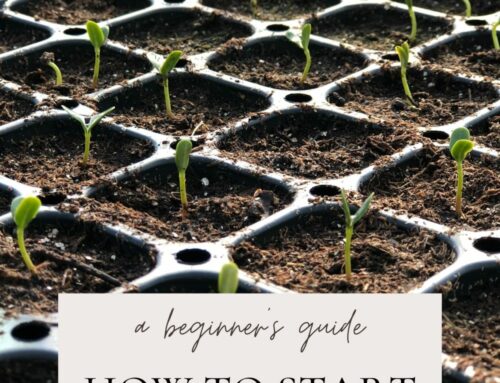
Spring Gardening: Essential Tasks to Prepare Your Garden for Spring
As spring unfolds, the garden starts to awaken from its winter slumber. It’s a time of transition, where the promise of new growth is in the air. With longer days and warmer temperatures ahead, spring is the time for gardeners to get their hands dirty and kickstart the growing season.
Whether you’re a seasoned gardener or just getting started, here are some essential tasks to tackle in the garden this spring:
Plan and Prepare:
- Make a list of all your seed crops you will be growing and when to start them
- Consider crop rotation, companion planting, and succession planting to maximize space and productivity
- Prepare any structures like trellises or raised beds
Start Seeds Indoors:
- Invest in seed trays, quality seed-starting medium, and grow lights if you don’t have a sunny windowsill. Starting seeds indoors gives your plants a head start and ensures they’ll be ready to transplant into the garden once the weather warms up
- Start cool-weather crops first and heat-loving annuals later (determine when by the “start ___weeks before last frost” on the seed packet)
Inspect Garden Tools and Equipment:
- Sharpen your pruners and shears, oil any moving parts, and make any necessary repairs or replacements. Having well-maintained tools will make gardening tasks much more manageable and enjoyable.
Healthy Soil is Key to healthy plants:
- Begin by assessing the soil in your garden beds. If it’s not too wet, you can start loosening compacted areas with a garden fork or tiller. I prefer no-till but I know that this method doesn’t work for every situation
- Conduct a soil test to determine its pH level and nutrient content. This will guide you in making any necessary amendments to ensure optimal plant growth
- If needed, incorporate compost or organic matter to improve soil structure and fertility, and add any necessary amendments identified by your soil test
Plant Cool-Season Flowers & Vegetables:
- Plant cool-season annuals like sweet peas, pansies, violas, and snapdragons, and cool-season vegetables starts like lettuce, spinach, broccoli, cauliflower and peas, which can all tolerate cooler temperatures
- Direct sow cold-hardy vegetables such as spinach, lettuce, and radishes, and carrots. Many flowers can also be direct-seeded. Refer to the seed packet for best way to grow each seed
Prune Shrubs and Trees:
- Remove any dead, damaged, diseased or crossing branches from shrubs and trees to encourage healthy growth, improve airflow and overall appearance
- If you have fruit trees or fruiting shrubs, like blueberries, in your garden, late winter to spring is the ideal time to prune them as well to encourage healthy fruit production later in the season
Divide Perennials:
- Many perennial plants benefit from being divided every few years to rejuvenate them and promote better growth. Divide plants like hostas, daylilies, and ornamental grasses. Simply dig up the clump, separate it into smaller sections, and replant them or pot them up and give them to your gardener friends
Lawn Maintenance:
- Aerate compacted or heavy use lawns
- Top dress with ¼” of compost over entire lawn
- Apply lime as directed on the package if needed to increase pH or sulphur if needed to decrease pH
- Reseed thin or bare patches
- Fertilize with a slow release organic fertilizer unless soil test indicates nitrogen is not needed
- Tune up lawn mower in preparation for the season
- Start mowing at height of 2.5”-3.5” when growth begins
Monitor Soil Moisture:
- Check the moisture levels in your soil, especially under eaves and in containers that are under covered porches. While it still may be raining, these plants will not receive any and will need supplemental water
- Remember to water deeply and less frequently to encourage deep root growth
Irrigation Systems:
- Consider installing drip irrigation or soaker hoses to deliver water directly to the roots of your plants, minimizing water waste
- Activate existing irrigation systems and test heads to check for repair needs (an irrigation company can be hired to do a ‘spring turn on’ and test of your system)
- Bury any exposed drip tubing
- Begin irrigating in June as weather warms or earlier if dry weather sets in
- Focus on deep but infrequent watering to grow deep roots that tolerate drought better
Clean Up the Garden:
- Remove any dead leaves, branches, or other debris that may have accumulated over the winter
- Remove weeds before they flower and go to seed.
- Dig out perennial weeds (dandelions, morning glory, buttercups. etc.) using a Hori Hori or garden knife to get entire root
- Remove annual weeds (shotweed, chickweed, etc.) by hand or by using a Hula Hoe to remove tops and prevent them from seeding
Tidy Border Edges:
- Edge your planting beds and borders to give your garden a clean look. This also helps to define the space and prevent grass and weeds from encroaching
Mulch Beds:
- Apply a layer of mulch to your planting beds and around trees and shrubs to suppress weeds, retain moisture, and regulate soil temperature. I prefer a dark composted bark for the best aesthetic and weed suppression
Design and Dream:
- Take some time to envision your dream garden. What does it look like and how does it feel? Is it relaxing, energizing, playful, or structured?
- Plan out new beds, pathways, or features you’d like to incorporate
- Make a list of plants to move and/or replace with ones better suited to your style or growing area
- If you need help, reach out to schedule a garden consultation
As you can see the list s spring to-do list is quite lengthy. Spring is a very busy time for the gardener! By tackling these essential tasks in early spring, you’ll set yourself up for a successful and bountiful growing season ahead.
Happy gardening!
Heidi







Thanks Heidi for garden clean-up list so well thought out. I am glad we can still prune after blooming to help the lawn mower-er. Lots of slugs too, everywhere.
Glad it was helpful Gigi!
Heidi